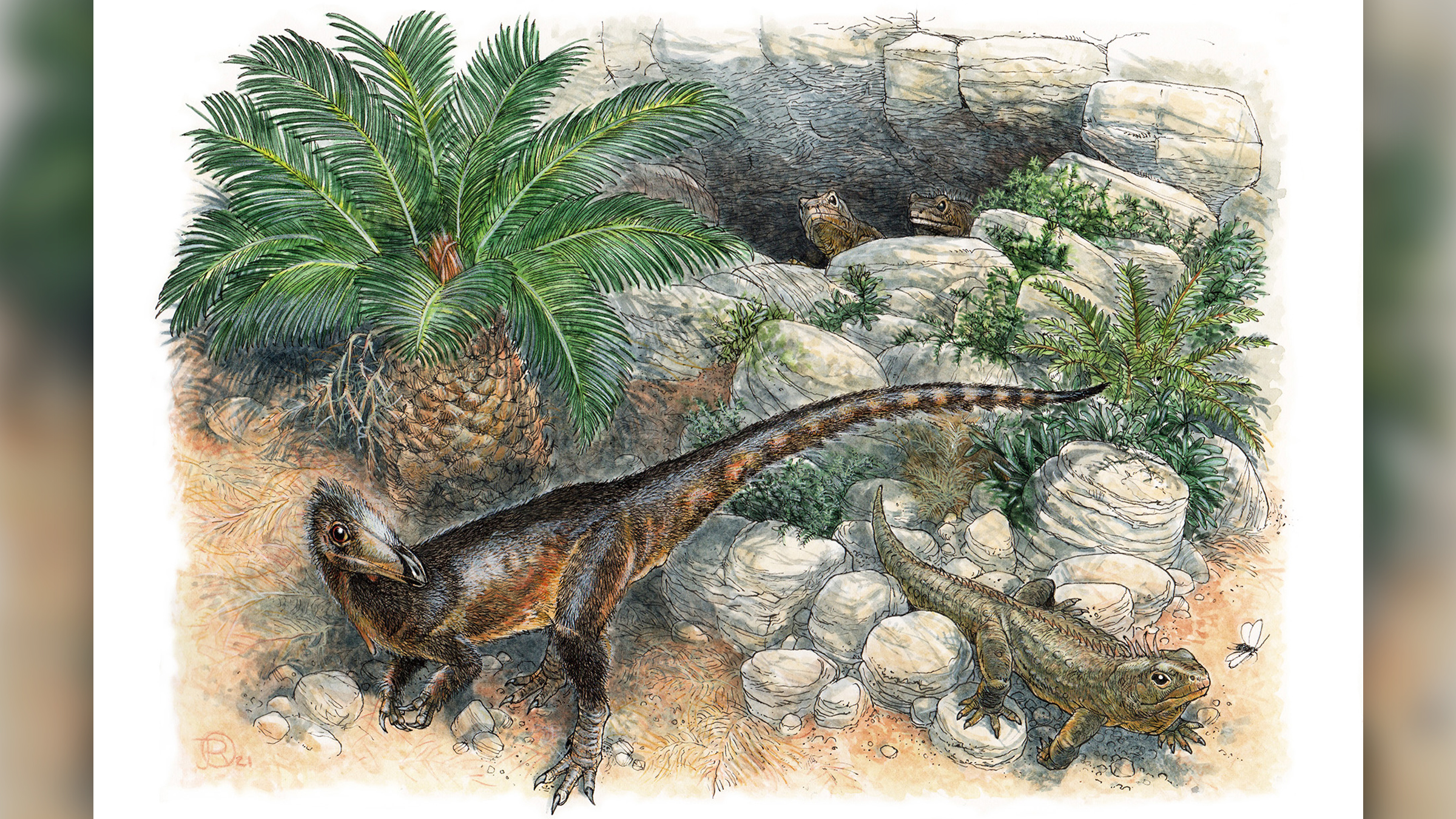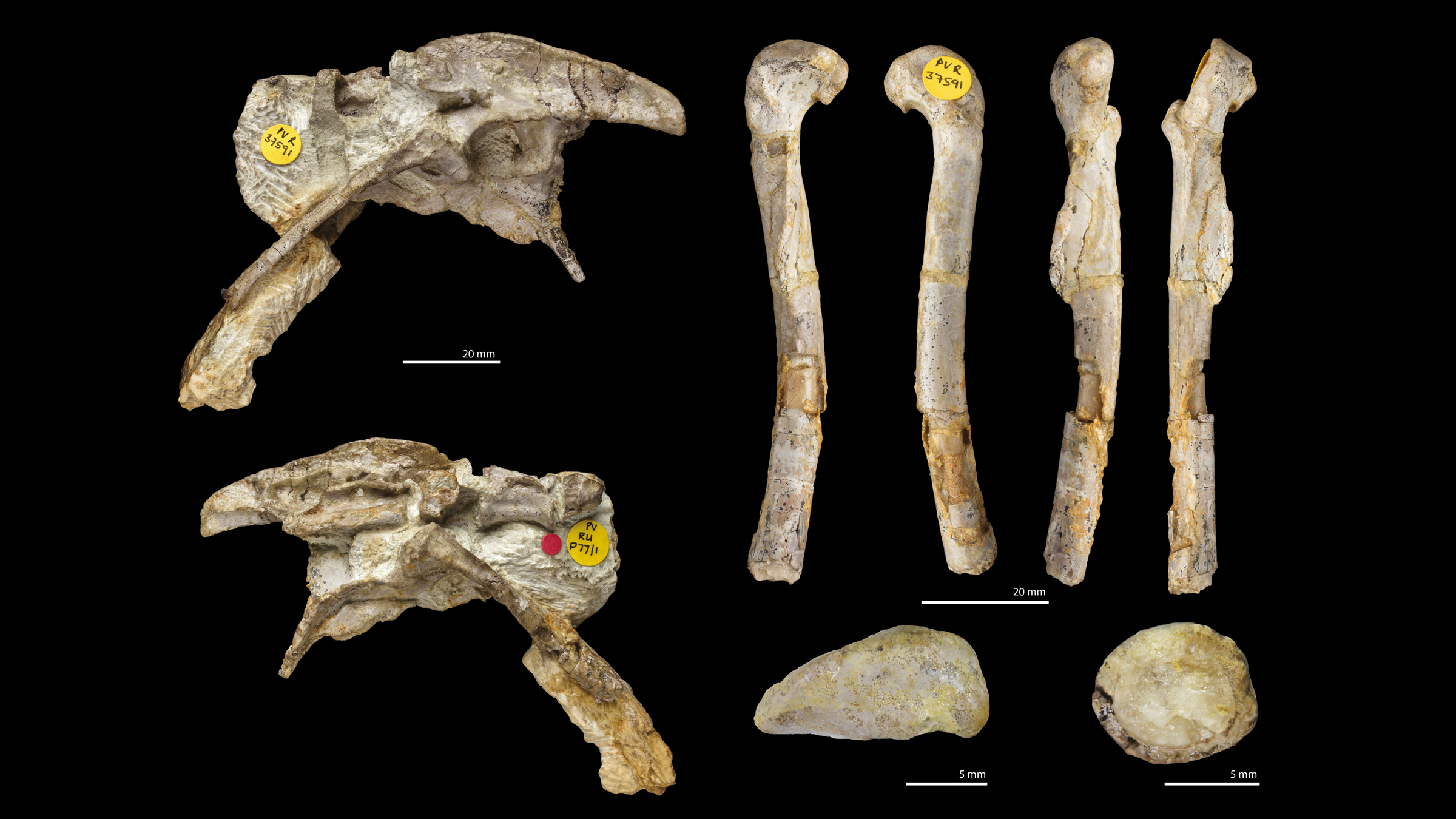Newfound 'chief dragon' dinosaur species was actually the size of a chicken
The island-dwelling dinosaur may have been a dwarf.

All hail "chief dragon": The oldest meat-eating dinosaur ever discovered in the United Kingdom may sound monstrous, but the clawed predator was actually a pip-squeak, a new study finds.
The chicken-size dinosaur lived in what is now Wales between 215 million and 200 million years ago, during the late Triassic period. It was likely an apex predator, despite its diminutive size, the researchers found, so, they named it Pendraig milnerae. Its genus name means "chief dragon" in Middle Welsh, a reference to the Medieval Welsh term "chief warrior," and its species name honors Angela Milner, a paleontologist at the Natural History Museum in London who helped locate the fossils of the species in the museum's collections before her death in August.
"Pendraig milnerae lived near the beginning of the evolution of the meat-eating dinosaurs," study first author Stephan Spiekman, a research fellow at the Natural History Museum who specializes in Triassic reptile evolution, said in a statement. "It's clear from the bones we have that it was a meat-eater, but early in the evolution of this group, these animals were quite small, in contrast to the very famous meat-eating dinosaurs like T. rex, which evolved much later."
Related: Photos: Newfound dinosaur had tiny arms, just like T. rex
Researchers described P. milnerae from an incomplete specimen, as well as two additional fragmentary specimens, discovered at a quarry in Pant-y-ffynnon, a village in southern Wales. The dinosaur's remains indicate that it was about 3 feet (1 meter) long, including its tail, and that it was a theropod — a group of bipedal, mostly meat-eating dinosaurs.
"It's an exciting discovery of a new species of theropod from the dawn of the dinosaurs (late Triassic), a time yielding less than a handful of such species in all of Europe (and the first from the UK)," Darla Zelenitsky, an associate professor of paleobiology at the University of Calgary in Alberta who was not involved with the study, told Live Science in an email. "It would have looked something like the tiny and seemingly cute (yet notorious) Compsognathus from the movie '[The Lost World:] Jurassic Park.'"
Although researchers discovered the chief's fossils decades ago, it wasn't identified as a newfound species until now. When study senior author Susannah Maidment, a senior researcher of paleobiology at the Natural History Museum, decided to reexamine its bizarre remains, she told Milner that she couldn't find the specimen, Maidment said in the statement. "And so she [Milner] went away, and about three hours later, she had it," Maidment said. "This paper would not have been possible without her."
Sign up for the Live Science daily newsletter now
Get the world’s most fascinating discoveries delivered straight to your inbox.
Milner was a theropod specialist who helped describe the "heavy-clawed" spinosaurid dinosaur Baryonyx walkeri in the 1980s, and she also studied the brain anatomy of Archaeopteryx, the earliest known birdlike dinosaur. "I am also happy to see this [new] dinosaur was named after Dr. Angela Milner, who did research on dinosaurs at a time when few women did," Zelenitsky said.

Dinosaur dwarf?
The chief dragon's slight stature may be a result of its environment, the researchers said.
"The area where these specimens were found was most likely an island during the time period in which it lived," Spiekman said. "Species which live on islands often tend to become smaller than those on the mainland in a phenomenon called island dwarfism."
To investigate this idea, Spiekman and his colleagues used statistical analyses to compare the size of P. milnerae with other early theropods and coelophysoids, a group within the theropod family that P. milnerae belonged to. But while some theropods evolved to be bigger during the Triassic, coelophysoids remained "considerably smaller," the researchers wrote in the study.
"The results indicate that Pendraig [milnerae] is indeed small, even for a theropod of that time period, but not uniquely so," Spiekman said.
What's more, it appears that the museum's fossils of P. milnerae might not be from fully mature individuals. "So Pendraig might have gotten somewhat bigger than the specimens we have so far, which limits our ability to perform reliable body size analyses," Spiekman said.
In other words, researchers will need to find more fossils of this species or other possible dinosaur dwarf species from the Triassic period in Wales to see whether island dwarfism occurred there. "If we could prove it, it would be the earliest known occurrence of this evolutionary phenomenon," Spiekman said.
But even if P. milnerae wasn't a dwarf, the finding is still a big deal for the region. "Dinosaur discoveries are really rare in Wales, and this is only the third dinosaur species known from the country," study co-researcher Richard Butler, a professor of paleobiology at the University of Birmingham in the United Kingdom, said in the statement.
The study was published online Wednesday (Oct. 6) in the journal Royal Society Open Science.
Originally published on Live Science.

Laura is the archaeology and Life's Little Mysteries editor at Live Science. She also reports on general science, including paleontology. Her work has appeared in The New York Times, Scholastic, Popular Science and Spectrum, a site on autism research. She has won multiple awards from the Society of Professional Journalists and the Washington Newspaper Publishers Association for her reporting at a weekly newspaper near Seattle. Laura holds a bachelor's degree in English literature and psychology from Washington University in St. Louis and a master's degree in science writing from NYU.









